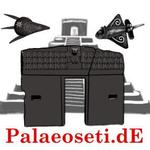Man hat im 1.und 2.Jh. in Palästina den Toten Münzen auf die Augen gelegt, damit die Augen geschlossen bleiben. Auch auf dem Grabtuch von Turin findet sich eine Münze aus der Zeit des Pontius Pilatus - nur ist es eine Fehlprägung. Ein Fälscher hätte also wissen müssen, dass es damals Pilatus-Münzen mit dieser Fehlprägung gab - was äußerst unwahrscheinlich ist. Im Duden werden übrigens auch absichtlich Fehler hineingeschrieben, um später vor Gericht in einem Plagiatsprozess anhand dieser Fehler beweisen zu können, dass jemand widerrechtlich aus dem Duden abgeschrieben hat (und das dann vermarktet hat). Also vor Gericht müsste das Grabtuch von Turin dann als echt durchgehen, es gälte als bewiesen, dass es nicht gefälscht sein kann, denn der Fälscher hätte ja sicher nicht gewusst, dass man Jesus ausgerechnet eine Fehlprägung auf das Augenlid gelegt hatte!
http://www.forumancientcoins.com/Articles/Pontius%20Pilate/Pilates_Coins_and_Turin_Shroud.htm"It all began at NASA in 1978. At this time researchers Jackson, Jumper and Stephenson wanted to test the capacities of their VP8 new computer, specially for three dimensional extrapolation, so they submitted the face on the shroud for analysis. The image obtained, now famous, distinctly revealed two circular protrusions on the eyelids. The experts immediately made a connection with an ancient custom which advocated the placing of coins on the eyes of the dead to keep them closed. Archaeological excavations have confirmed this tradition. Skeletons from the first and second century C.E. have been found with a coin in each eye-socket at Jericho and at En Boqeq.
Everything then happened very quickly. The following year Professor Francis Filas, a teacher at Loyola University of Chicago, made an enlargement of the image of the left eye and noticed a strange curved shape with traces of letters above it. Intrigued, he went to a ancient coins expert from Chicago, Michael Marx, who concluded that it was probably the image of Pilate's lituus coin. I have reproduced the relevant illustration so that anyone may form their own opinion on the matter.
In 1980, an electronic analysis performed in the Overland Park Laboratory in Texas confirmed not only the soundness of Professor Filas' findings, but also allowed the admission of evidence of another coin on the right eye, without however being able to identify why precise details were absent. Other researchers, Alan and Mary Wanger, took up the investigation in 1985, applying the technique of polarised light superimposition; they though they detected on the left eye coin the three ears of barley encircled with faint traces of letters: this indicated that it could be the coin minted in year 29.
What credibility may be given to these "discoveries" ? Like everything else touching on the Turin Shroud, each discovery, whether in favour of its authenticity or against, is immediately contested by supporters holding the opposite view. The thesis of PilateÕs coins on the eyes is neither more or less argued about than any other discovery or supposition concerning this shroud.
For my part, I must admit that I have failed to detect any trace of the year 29 coin on the right eye. On the other hand, the similarity of the centre left eye image to a coin bearing the lituus motif is actually more disturbing. The round form gives an impression suggestive of the lituus cross, (albeit a little less curved than in usual) surrounded by traces of letters which could be a vestige of the centre of the inscription "TIBEPIOY KAICAPOC".
A remarkable web site : www.shroud.com/lombatti.htm presents all the details of this controversy (more than 20 pages)"
http://www.forumancientcoins.com/Articles/Pontius%20Pilate/Pontius_Pilatus.htmlJimmybondy schrieb am 03.05.2010:Als Gegenargument für die Da Vinci Befürworter als Erschaffer ist es doch brauchbar, da dieser ja 1192 noch nicht auf der Welt war.





